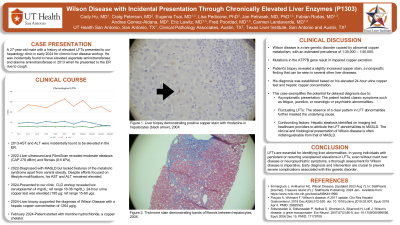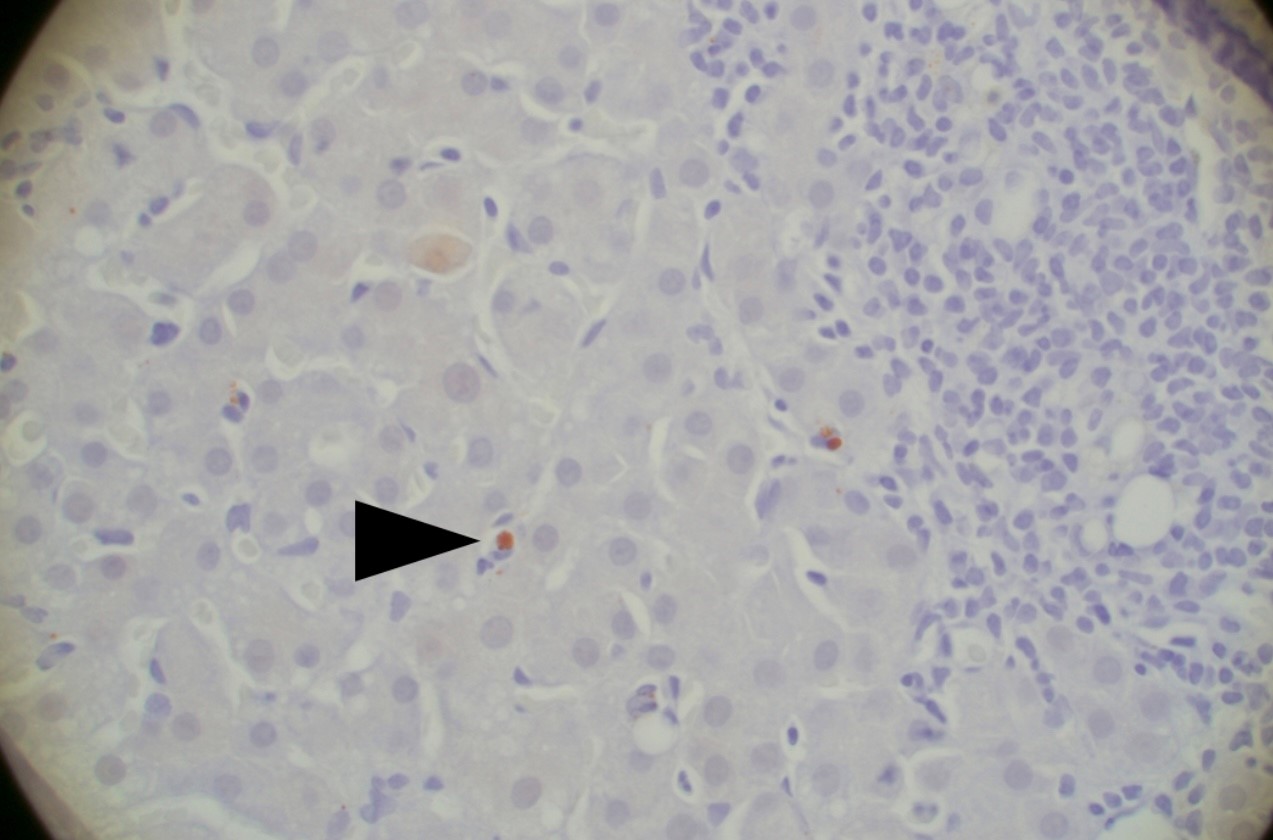Sunday Poster Session
Category: Liver
P1303 - Wilson Disease With Incidental Presentation Through Chronically Elevated Liver Enzymes
Sunday, October 27, 2024
3:30 PM - 7:00 PM ET
Location: Exhibit Hall E

Has Audio
- CH
Cody Hu, MD
University of Texas Health San Antonio
San Antonio, TX
Presenting Author(s)
Cody Hu, MD1, Craig Peterson, MD2, Eugenia Tsai, MD3, Lisa Pedicone, PhD3, Jan Petrasek, MD, PhD3, Fabian Rodas, MD3, Andres Gomez-Aldana, MD3, Eric J. Lawitz, MD4, Fred Poordad, MD3, Carmen Landaverde, MD5
1University of Texas Health San Antonio, San Antonio, TX; 2Clinical Pathology Associates, Austin, TX; 3Texas Liver Institute, San Antonio, TX; 4The Texas Liver Institute, University of Texas Health, San Antonio, TX; 5Texas Liver Institute, Austin, TX
Introduction: Wilson disease (WD) is a rare genetic disorder caused by abnormal copper metabolism. We report a case of WD that was misdiagnosed with metabolic dysfunction-associated steatotic disease (MASLD) resulting in a delay of appropriate treatment for years.
Case Description/Methods: A 27-year-old male with persistently elevated aminotransferases presented for chronic liver disease (CLD) evaluation. Elevated aspartate aminotransferase (AST) and alanine aminotransferase (ALT) were incidentally noticed during a 2013 ER visit for cough and fluctuated between 100-500 U/L over subsequent years. In 2022, liver ultrasound and FibroScan revealed moderate steatosis (CAP 278) and fibrosis (8.6 kPa). He was diagnosed with MASLD, however he lacked features of the metabolic syndrome with the exception of central obesity. Despite efforts focused on lifestyle modifications, his AST and ALT remained elevated. In 2024, CLD workup revealed normal iron studies and alpha-1 antitrypsin level but low ceruloplasmin (4 mg/dL; ref range 18-36 mg/dL). 24-hour urine copper test was elevated (185 μg; ref range 15-60 μg), establishing his diagnosis of WD. He underwent a liver biopsy that supported the diagnosis of WD with a hepatic copper concentration of 1264.1 μg/g (Figure 1). Copper chelator trientine was started, and he remained asymptomatic with down-trending aminotransferases.
Discussion: WD, caused by mutations in the ATP7B gene, results in impaired copper excretion. Copper accumulation in different organs, especially the liver, brain, and eyes, can cause various symptoms including jaundice, neuropsychiatric abnormalities, and Kayser-Fleischer rings. The variable presentation and wide age of onset (2-80 years) contribute to diagnostic challenges. In this case, the lack of classic symptoms resulted in a delay of diagnosis. The absence of a clear pattern in AST and ALT levels further masked the underlying cause. Hepatic steatosis on imaging study may lead to misattributing aminotransferase abnormalities to MASLD since WD can present with such findings. This patient’s biopsy revealed a slightly increased copper stain, a nonspecific finding that can be seen in several other liver diseases. His diagnosis was established based on his ceruloplasmin < 10 mg/dL and his 24-hour urinary copper excretion >100 μg. This case highlights the importance of comprehensive evaluation of unexplained elevated liver enzymes to ensure timely diagnosis and intervention of WD.

Disclosures:
Cody Hu, MD1, Craig Peterson, MD2, Eugenia Tsai, MD3, Lisa Pedicone, PhD3, Jan Petrasek, MD, PhD3, Fabian Rodas, MD3, Andres Gomez-Aldana, MD3, Eric J. Lawitz, MD4, Fred Poordad, MD3, Carmen Landaverde, MD5. P1303 - Wilson Disease With Incidental Presentation Through Chronically Elevated Liver Enzymes, ACG 2024 Annual Scientific Meeting Abstracts. Philadelphia, PA: American College of Gastroenterology.
1University of Texas Health San Antonio, San Antonio, TX; 2Clinical Pathology Associates, Austin, TX; 3Texas Liver Institute, San Antonio, TX; 4The Texas Liver Institute, University of Texas Health, San Antonio, TX; 5Texas Liver Institute, Austin, TX
Introduction: Wilson disease (WD) is a rare genetic disorder caused by abnormal copper metabolism. We report a case of WD that was misdiagnosed with metabolic dysfunction-associated steatotic disease (MASLD) resulting in a delay of appropriate treatment for years.
Case Description/Methods: A 27-year-old male with persistently elevated aminotransferases presented for chronic liver disease (CLD) evaluation. Elevated aspartate aminotransferase (AST) and alanine aminotransferase (ALT) were incidentally noticed during a 2013 ER visit for cough and fluctuated between 100-500 U/L over subsequent years. In 2022, liver ultrasound and FibroScan revealed moderate steatosis (CAP 278) and fibrosis (8.6 kPa). He was diagnosed with MASLD, however he lacked features of the metabolic syndrome with the exception of central obesity. Despite efforts focused on lifestyle modifications, his AST and ALT remained elevated. In 2024, CLD workup revealed normal iron studies and alpha-1 antitrypsin level but low ceruloplasmin (4 mg/dL; ref range 18-36 mg/dL). 24-hour urine copper test was elevated (185 μg; ref range 15-60 μg), establishing his diagnosis of WD. He underwent a liver biopsy that supported the diagnosis of WD with a hepatic copper concentration of 1264.1 μg/g (Figure 1). Copper chelator trientine was started, and he remained asymptomatic with down-trending aminotransferases.
Discussion: WD, caused by mutations in the ATP7B gene, results in impaired copper excretion. Copper accumulation in different organs, especially the liver, brain, and eyes, can cause various symptoms including jaundice, neuropsychiatric abnormalities, and Kayser-Fleischer rings. The variable presentation and wide age of onset (2-80 years) contribute to diagnostic challenges. In this case, the lack of classic symptoms resulted in a delay of diagnosis. The absence of a clear pattern in AST and ALT levels further masked the underlying cause. Hepatic steatosis on imaging study may lead to misattributing aminotransferase abnormalities to MASLD since WD can present with such findings. This patient’s biopsy revealed a slightly increased copper stain, a nonspecific finding that can be seen in several other liver diseases. His diagnosis was established based on his ceruloplasmin < 10 mg/dL and his 24-hour urinary copper excretion >100 μg. This case highlights the importance of comprehensive evaluation of unexplained elevated liver enzymes to ensure timely diagnosis and intervention of WD.

Figure: Figure 1. Liver biopsy demonstrating positive copper stain with rhodanine in hepatocytes (black arrow), 200X
Disclosures:
Cody Hu indicated no relevant financial relationships.
Craig Peterson indicated no relevant financial relationships.
Eugenia Tsai indicated no relevant financial relationships.
Lisa Pedicone indicated no relevant financial relationships.
Jan Petrasek indicated no relevant financial relationships.
Fabian Rodas indicated no relevant financial relationships.
Andres Gomez-Aldana indicated no relevant financial relationships.
Eric Lawitz: 89Bio – Consultant, Grant/Research Support. Akero – Consultant, Grant/Research Support. Alnylam – Consultant, Grant/Research Support. Amgen – Consultant, Grant/Research Support. AstraZeneca – Consultant, Grant/Research Support. Axcella Health – Consultant, Grant/Research Support. Boehringer Ingelheim – Consultant, Grant/Research Support. Bristol Myers Squibb – Consultant, Grant/Research Support. CymaBay, a Gilead Sciences Company – Consultant, Grant/Research Support. CytoDyn – Consultant, Grant/Research Support. DSM – Consultant, Grant/Research Support. Durect – Consultant, Grant/Research Support. Eli Lilly – Consultant, Grant/Research Support. Enanta – Consultant, Grant/Research Support. Enyo – Consultant, Grant/Research Support. Exalenz – Consultant, Grant/Research Support. Galectin – Consultant, Grant/Research Support. Galmed – Consultant, Grant/Research Support. Genentech – Consultant, Grant/Research Support. Genfit – Consultant, Grant/Research Support. Gilead Sciences, Inc. – Consultant, Grant/Research Support. GSK – Consultant, Grant/Research Support. Hanmi – Consultant, Grant/Research Support. Hightide – Consultant, Grant/Research Support. Intercept – Consultant, Grant/Research Support. Inventiva – Consultant, Grant/Research Support. Ipsen – Consultant, Grant/Research Support. Janssen – Consultant, Grant/Research Support. Madrigal – Consultant, Grant/Research Support. Merck & Co – Consultant, Grant/Research Support. NGM – Consultant, Grant/Research Support. Northsea – Consultant, Grant/Research Support. Novartis – Consultant, Grant/Research Support. Novo Nordisk – Consultant, Grant/Research Support. Pfizer – Consultant, Grant/Research Support. Poxel Co – Consultant, Grant/Research Support. Roche – Consultant, Grant/Research Support. Sagimet – Consultant, Grant/Research Support. Terns – Consultant, Grant/Research Support. Viking – Consultant, Grant/Research Support. Zydus – Consultant, Grant/Research Support.
Fred Poordad indicated no relevant financial relationships.
Carmen Landaverde indicated no relevant financial relationships.
Cody Hu, MD1, Craig Peterson, MD2, Eugenia Tsai, MD3, Lisa Pedicone, PhD3, Jan Petrasek, MD, PhD3, Fabian Rodas, MD3, Andres Gomez-Aldana, MD3, Eric J. Lawitz, MD4, Fred Poordad, MD3, Carmen Landaverde, MD5. P1303 - Wilson Disease With Incidental Presentation Through Chronically Elevated Liver Enzymes, ACG 2024 Annual Scientific Meeting Abstracts. Philadelphia, PA: American College of Gastroenterology.
